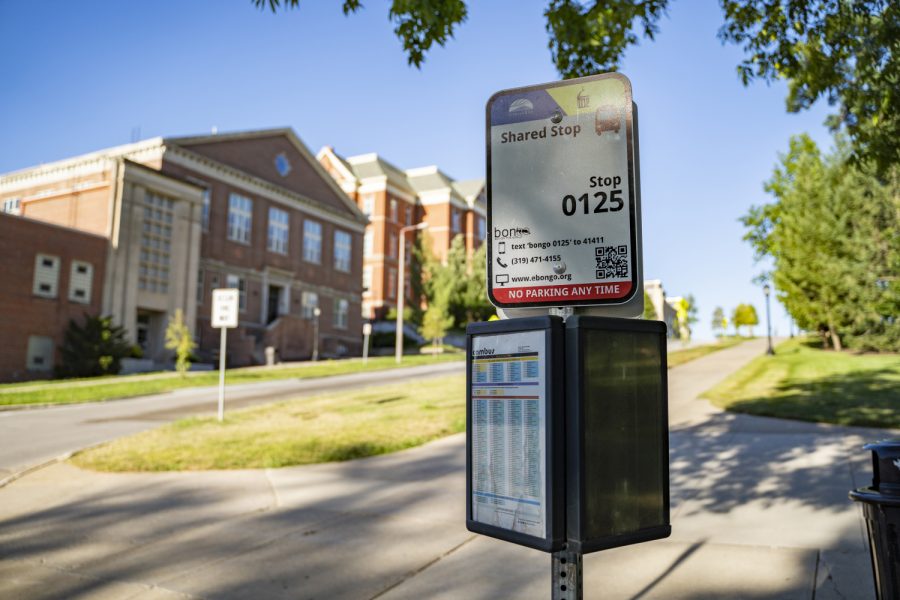Cambus to temporarily close stops, with updated routes and mitigation efforts
The University of Iowa’s Cambus shuttle service is temporarily eliminating stops deemed walkable as one of many efforts the student run transit service is taking to prioritize health and safety for riders.
Cambus stop 0125 for the IMU is seen on Monday, July 27, 2020. This stop is one of many that are deemed “walkable” and are being closed for the Fall 2020 semester in response to COVID-19.
August 3, 2020
Cambus routes are shifting and stops deemed walkable will be temporarily eliminated as campus transit operations prepare to resume campus services at the University of Iowa on August 17, to prioritize health and safety and slow the spread of the coronavirus.
Mia Brunelli, Cambus operations manager, said that simplifying routes by providing more direct and high-frequency rides have both been a part of adjusting services to meet critical needs on campus while maintaining safety.
“Starting off going into fall, we looked at stops that are either already very close to other stops — the more times a bus stops on its way to a destination, the longer it takes for that bus to complete its routes,” Brunelli said. “By reducing some of the stops it just allows our routes to move more efficiently though campus [and] that reduces the amount of riding time …We looked at stops that were already really close to other stops, and then we looked at stops that are within trips that are usually very short.”
Brunelli said the stops will be temporarily closed through Nov. 20, partly to discourage people from using the Cambus service for shorter trips.
Map by Kelsey Harrell/The Daily Iowan
“Considering walking distance, a ten-minute walk is considered pretty reasonable in Iowa weather through early November, and if someone is using a bus to make that ten-minute trip, we look to make the service a little more inconvenient so we can better serve the trips that are further away,” Brunelli said.
There aren’t any changes to Bionic Bus operations this fall, Brunelli added, which is a door-to-door service for people with disabilities.
“If any of our stop eliminations or changes in our route structures does affect a student or a staff or faculty member with a disability being able to make their trips, then they would qualify for the Bionic service and can go through that process,” Brunelli said.
A lot of Cambus services also focus on commuters for UI Hospitals and Clinics, Brunelli said. Over the summer, the tweaks made to the commuter side have proven to be effective in reducing the number of people on a bus at a time, she said.
“That’s kind of been a great sort of pilot program for what we’re going to try to model in the fall with the more student-centered focus service on the east side and between the residence halls,” she said.
Related:Cambus changes routes to accommodate for University of Iowa Hospitals & Clinics
Brunelli added that the UI is requiring everyone on the buses to wear a mask, though Cambus hasn’t been given methods to strictly enforce the requirement.
“Our bus drivers — their primary responsibility is safely operating the bus, so at this time we haven’t been directed on what that strategy might be for strict enforcement,” Brunelli said. “We do have signs posted at bus stops, inside the buses. We’ll also be putting a sign outside of the bus to remind passengers as they get on to please be wearing a face covering in line with university policy.”
April Wells, communications manager for UI Parking and Transportation, said part of the UI’s hope is that riding the bus will become something normal and routine for people to do on campus while wearing a mask.
“I think one of the goals that the university has is that as students come back to face-to-face instruction and staff and faculty too … that it becomes just part of your normal routine, as it probably is for you and your personal life already, when you’re going out to stores and shops, when you’re going out to public places where you can’t maintain that six feet of distance,” Wells said.
Wells added that Cambus is currently working on developing a campus walking map so that students who might not be aware of some of the pedestrian routes can familiarize themselves with different areas of campus and plan their walking trips more easily.
Wells said the map will be up on the Cambus website in the upcoming weeks.
Related: Some local University of Iowa students opt to live at home instead of on campus in fall 2020
Cambus manager Brian McClatchey said a staff member timed themselves walking along the routes that will be highlighted on the map, so students will be able to gauge time.
McClatchey said the response from Cambus drivers about the updated service plan has been positive.
“I think everyone’s on board with what we’re trying to accomplish … It’s been kind of difficult trying to design a service to discourage people from riding the bus and use more walking, but in addition to that, we are providing PPE to the drivers,” McClatchey said. “We also do daily disinfecting of the buses. We provide disinfectant for the drivers so if there’s a driver change, they’re able to do some disinfecting in the driver’s area.”
McClatchey noted there will be no hard maximum to the number of passengers allowed on buses, because it would be difficult for drivers to enforce.
“We’re hoping to accomplish a significantly reduced number of people on the bus through our service design,” McClatchey said.
McClatchey said Cambus adapted to challenges and made regular adjustments to its services since March, but as recommendations and circumstances change, it’s impossible to gauge the future.
“The number one challenge is the unknown,” McClatchey said.

















